by
[user not found]
| Jul 28, 2014
1. Manufacturing Jobs Are Returning to the United States
Contrary to widely held beliefs that "We don't make anything here anymore", manufacturing is actually returning to the United States. Not only do we make things here, we are making more and more things here every day.
In the last few years, many companies including Walmart, Apple, Motorola, General Electric, Ford and many more, have begun moving manufacturing facilities out of China and re-establishing them in the United States. If you haven't visited www.reshorenow.org, you should check it out.
One New York Times piece summarized what the most common answers from 200 decision makers across varying industries chose to come back to the United States. The answers were "competitive labor rates, proximity to customers, product quality, skilled labor and transportation costs".
Moreover, China is no longer looking like an attractive place for manufacturers to set up shop. One Forbes article found that the main reasons China is losing its attractiveness is that "oil prices are three times what they were in 2000. Natural gas in the US is a quarter of what it is in Asia. Chinese wages are five times what they were in 2000. And labor is a steadily decreasing percentage of the cost manufacturing."
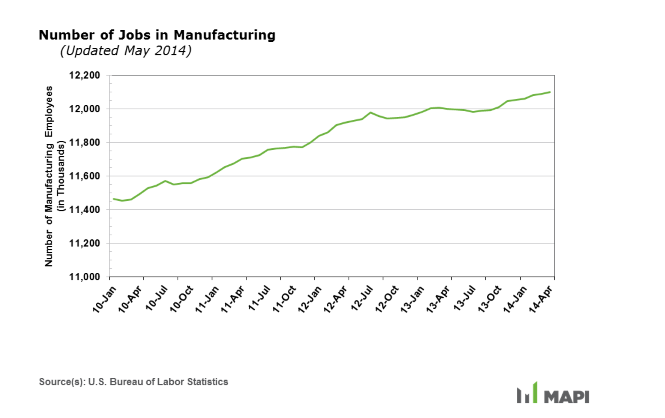
2. The First Factory Established in the United States was Slater's Mill in Pawtucket, Rhode Island (Go Rhody!)
When people imagine the Industrial Revolution, contraptions including Eli Whitney's cotton gin, James Watt's steam engine or Samuel Morse's telegraph. But few would think cotton mill in Pawtucket, Rhode Island.
Samuel Slater, an English-American industrialist, was the first man to use manufacturing machinery in the United States. Slater, who worked from apprenticeship to owner and superintendent of a cotton spinning mill in Derbyshire, England, developed a strong familiarity and knowledge of cotton spinning technology developed by British inventor Richard Arkwright. In 1789, Slater emigrated to the United States, leaving his work in England behind with ambitions of wealth in the budding America.
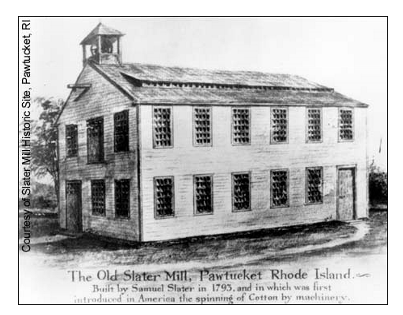
Slater however needed to work covertly to establish what would be his legacy as an industrialist in America. British textile law forbade textile workers from sharing technological information or leaving the country.
Upon landing in Rhode Island, Slater (with the help of Rhode Island merchant Moses Brown) built America's first water powered cotton spinning mill in Pawtucket, Rhode Island along the Blackstone River. The factory thrived for many decades and by 1803 the mill town of Slatersville was established to house and support the families that worked in Slater's mills.
3. U.S. Manufacturing is the World's Eighth Largest Economy
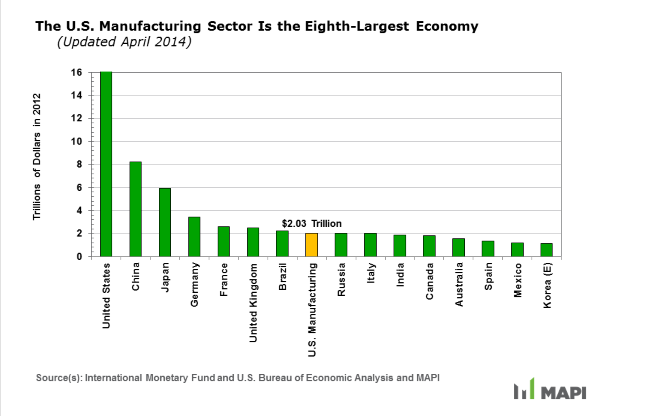
In 2012, American manufacturers generated $2.03 trillion in revenue. The U.S. manufacturing sector is so huge that if it were its own country, it would rank as the eighth-largest world economy. The United States produces the most goods and services overall as measured by gross domestic product (GDP), and is far ahead of second-place China.
Between 1992 and 2012, American manufacturing output increased more than 83 percent.
4. The United States is the 4th Easiest Country to do business with
Each year, the World Bank performs a comprehensive analysis of structural costs to start and conduct business in virtually every country in the world. Typically, advanced economies tend to receive higher rankings while less developed countries tend to receive lower rankings.
While the United States is and has ranked among the top 5 easiest countries to do business with, it is not number one. Currently, the U.S. ranks fourth in terms of the ease of doing business, and Singapore, Hong Kong, and New Zealand are ahead of us. There's a great opportunity to improve to become the #1 manufacturing economy that is also the easiest to do business with.
5. Food Manufacturing is the United States Largest Manufacturing Sector
While many might think that automotive is the leading manufacturing sub sector for employment, food and beverage is actually at the top of the list by considerable margin.
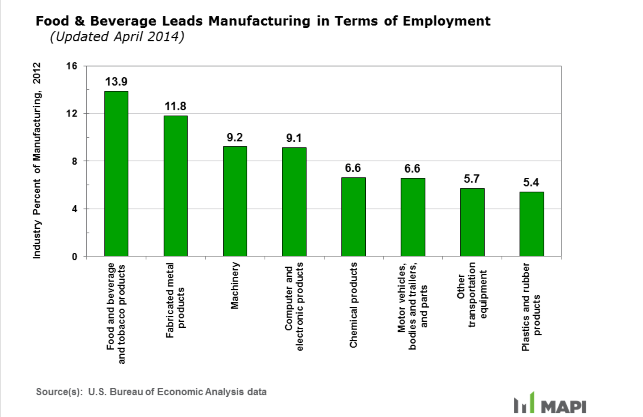
With almost 13.9 million employed in food, beverage and tobacco manufacturing, this industry leads the pack in American manufacturing. Within this industry, meat and poultry take the lead at 32% of the total industry breakdown according to a 2011 analysis by the USDA Economic Research Service.
6. Manufacturing job gains are the largest in Wyoming; lowest in Washington D.C.
With American manufacturing jobs on the rebound, growth is progressing at a steady, consistent rate, with the Midwest and Northwest out performing other regions.
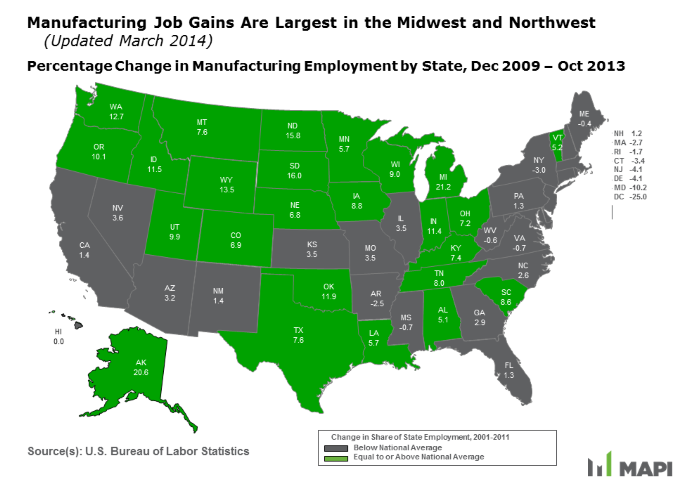
While many states have lost their manufacturing sectors relatively quickly, others have retained them and even strengthened them. According to a new survey put out by the US Bureau of Labor Statistics, States as of March 2014, states that have added additional manufacturing jobs and sit well above the national average in manufacturing employment, Wyoming has gained 11% additional jobs in manufacturing. Washington state and Oregon follow close behind with 12% and 10% respectfully.
Conversely, there are states that have lost considerable portions of their manufacturing industries and fall well below the national average. Washington D.C. is well below the national average at -25%. Maryland, Delaware, New Jersey and much of New England have fallen considerably below the national average for manufacturing jobs posting numbers including -10%, and -4%.
On average, the Northwest and Midwest states have experienced above average increases in manufacturing employment while states in the East and Southwest are recovering at a slower pace.
7. Oregon's manufacturing sector makes up 58% of its state economy
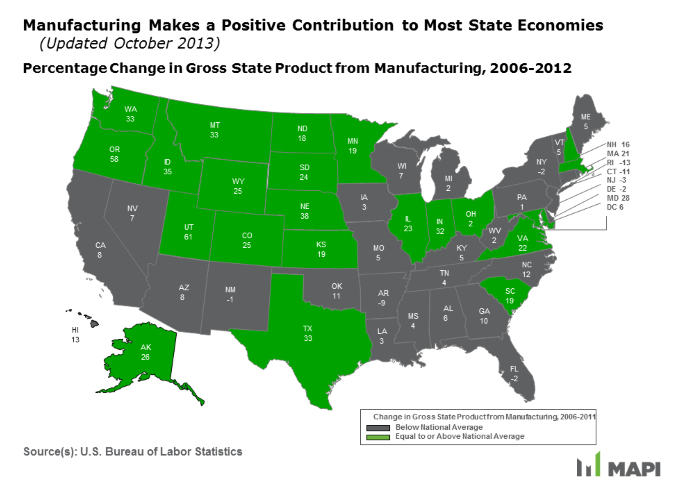
No that's not a typo.
Oregon has developed a tremendous manufacturing sector in recent years. The state's output has increased 8 times since 1997 and reaps a 75 billion dollar per year reward.
Bear in mind: Oregon is not a large state. The jump in manufacturing output is so significant it now trumps former manufacturing power houses including Indiana, Michigan and Pennsylvania.
What's the root cause? Technology.
Electronic circuit boards, processors and controllers were the state's largest exports in 2012. Intel, whose home headquarters resides in Santa Clara, California, controls 6 manufacturing facilities in Oregon which employ over 17,000 workers making it one of Oregon's largest private employers.
8. Industrial manufacturing leads in renewable energy use
Renewable energy is a very hot topic these days and whether or not corporations should take responsibility and do their part in halting climate change.
Fortunately, many industries have taken steps to do their part and the industrial manufacturing sector has been leading the pack among other manufacturing subsectors. Manufacturing leads the charge in adopting renewable energy with 2,269 trillion BTUs of renewable energy compared to other sectors including transportation with 1,158 trillion, residential with 652 trillion and commercial 132 trillion BTUs.